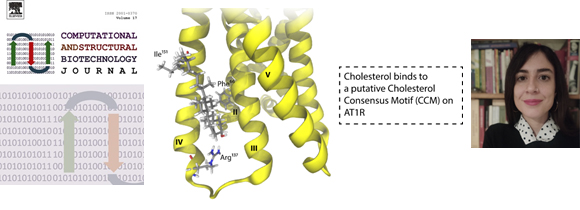Contribution of Organic Chemistry in the understanding of the Role of Cholesterol in Hypertension (T. Mavromoustakos group)
Cholesterol is an essential component of our cellular membranes. Cholesterol is responsible for a plethora of functions in cellular membranes. It regulates their fluidity so that they respond in temperature changes without being subjected to damages while it also affects the way in which pharmaceutical molecules act on transmembrane receptors. Such a receptor is AT1, where the antihypertensive molecules, sartans, bind in order to block the detrimental action of the octapeptide hormone angiotensin II, in pathological conditions. The way in which sartans bind to the receptor is unknown in the molecular level. They could bind directly to the receptor via the extracellular area or indirectly through initial penetration in the bilayers and subsequent lateral diffusion to the receptor’s binding site. Cholesterol is shown to allosterically interact with the receptor, possibly facilitating the binding of AT1 antagonists. On the other hand, it is shown to retard the diffusion of the drugs in the lipid bilayers. This dual role of cholesterol which was highlighted by our research group, during the PhD thesis of Mrs Sofia Kiriakidi, in collaboration with the research groups of Assoc. Prof. A. Tzakos and Researcher B’ Z. Cournia, opens up new horizons for the understanding of the sartan action mechanism in the molecular level and the rational design of novel drugs.
This work was published in the Computational and Structural Biotechnology Journal with an impact factor of 6.018.
Kiriakidi S, Chatzigiannis C, Papaemmanouil C, Tzakos AG, Cournia Z, Mavromoustakos T. Interplay of cholesterol, membrane bilayers and the AT1R: A cholesterol consensus motif on AT1R is revealed. Comput Struct Biotechnol J. 2020 Dec 3;19:110-120. doi: 10.1016/j.csbj.2020.11.042.

